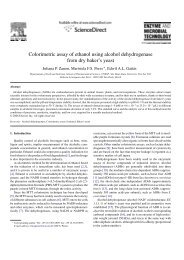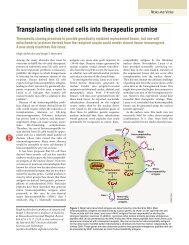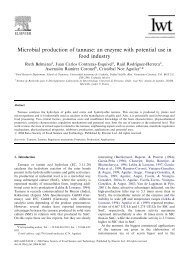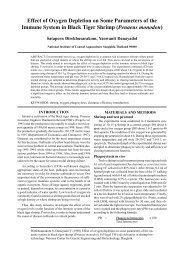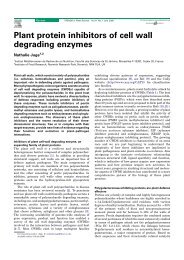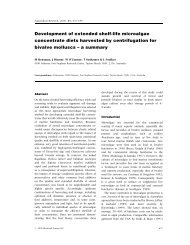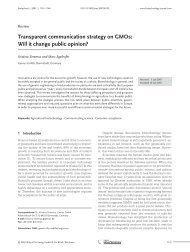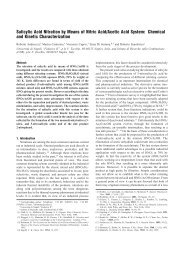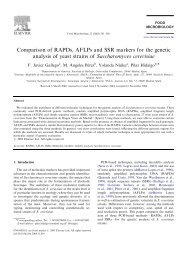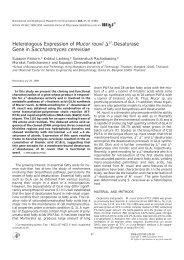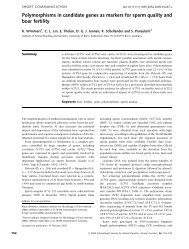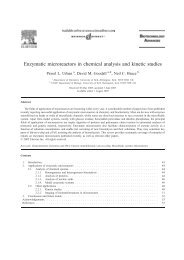Crassostrea giga - Biotechnology
Crassostrea giga - Biotechnology
Crassostrea giga - Biotechnology
You also want an ePaper? Increase the reach of your titles
YUMPU automatically turns print PDFs into web optimized ePapers that Google loves.
Figure 1. Neutral lipids and polar lipids of oysters (mean ± standard<br />
deviation, n ) 6). OCG, oyster control group; OS, oysters supplemented<br />
by S. costatum; OI, oysters supplemented by T. isochrysis; S0, control<br />
point; S6, level after 6 weeks of experimentation.<br />
was low compared to that of the oyster control group after 6<br />
weeks of experimentation. Knauer and Southgate (19) have<br />
shown the retention of this fatty acid in unfed spat oysters,<br />
proving its essential character.<br />
T. isochrysis contains C18:3 n-3 (6.9% versus 0.1% for the<br />
diatom), which led to an increase of its presence in oysters.<br />
C18:4 n-3 fatty acid content was found to be low in oysters<br />
fed the flagellate. This result is in agreement with the results of<br />
McCausland et al. (6), who showed that this fatty acid was not<br />
retained in the lipid content of juvenile oysters. In oysters<br />
fattened by T. isochrysis, the C20:5 n-3 content decreased and<br />
that of C22:6 n-3 tended to stay steady, thus showing that there<br />
was no elongation of the C18:3 n-3 (found in abundance in<br />
oysters) in C20:5 n-3 and C22:6 n-3. Moreover, oysters were<br />
not able to elongate C18:3 n-3 to C18:4 n-3. These results<br />
are in accordance with those of Langdon and Waldock (20). In<br />
relation to the level of C20:5 n-3 in the two microalgae, it<br />
increased significantly in oysters supplemented by S. costatum<br />
and decreased significantly in those fed T. isochrysis. Inthe<br />
same way, the content of C22:6 n-3 was steady in the oysters<br />
supplemented by T. isochrysis, whereas it was significantly<br />
lower in oysters fattened by S. costatum, due to the low amount<br />
of C22:6 n-3 inS. costatum. Oysters are able to incorporate<br />
these essential fatty acids in their lipids. The significant<br />
difference (p < 0.05) for n-3 fatty acid content in oysters<br />
supplemented by the two microalgae was essentially due to the<br />
large decrease in C20:5 n-3 in oysters fattened by T. isochrysis<br />
and its large increase in oysters fattened by S. costatum.<br />
The content of PUFA in the oyster control group after 6 weeks<br />
of experimentation and in oysters supplemented by S. costatum<br />
was not significantly different. Nevertheless, the content of n-6,<br />
n-4, and n-1 fatty acids was significantly different between<br />
these two groups of oysters. The sum of n-6, n-4, n-3, and<br />
n-1 fatty acids resulted in an equal level of PUFA but a<br />
different fatty acid profile.<br />
Figure 1 shows that the oyster control group at the beginning<br />
and after 6 weeks of experimentation had an equivalent<br />
distribution of neutral and polar lipids (phospholipids and<br />
glycolipids). The glycolipid level was low. The oyster control<br />
group contained more phospholipids than neutral lipids, as<br />
shown by Soudant et al. (10) in juvenile oysters. Oysters<br />
supplemented by microalgae had a neutral lipid level that<br />
increased to the detriment of polar lipids. The fatty acids of<br />
microalgae are accumulated in neutral lipids and to a lesser<br />
extent in phospholipids, according to the results of Piveteau et<br />
al. (8). Caers et al. (22) have shown that neutral lipids are used<br />
as an energy source and phospholipids as a reserve energy<br />
source.<br />
Figure 2 shows the profile of C20:5 n-3 and C22:6 n-3 in<br />
neutral lipids and in phospholipids. The fatty acid profile of<br />
neutral lipids showed the same trends as for total lipids, unlike<br />
phospholipids, for which the differences were less marked,<br />
especially for the oyster control group. For oysters supplemented<br />
by S. costatum, C20:5 n-3 was accumulated in great amounts<br />
in neutral lipids. Oysters supplemented by T. isochrysis had a<br />
decreasing level of C20:5 n-3 both in neutral lipids and in polar<br />
lipids, and the C22:6 n-3 fatty acid content was steady both in<br />
neutral lipids and in phospholipids. The decrease of C22:6 n-3<br />
in oysters supplemented by S. costatum suggests the poor ability<br />
of oysters to elongate and desaturate fatty acids such as C20:5<br />
n-3, which are highly present in this microalgae. Waldock and<br />
Holland (23) have shown that juvenile oysters are able to<br />
elongate and desaturate long-chain fatty acids, but not in<br />
sufficient quantity to cause an accumulation.<br />
Factors implicated in the different biochemical compositions<br />
of oysters fed S. costatum and T. isochrysis are the ability to<br />
be ingested, the ability to be digested, and the biochemical<br />
composition of the microalgae (9). This experiment shows the<br />
ability of oysters to assimilate both microalgae. The increase<br />
in the condition index of oysters fattened by microalgae reveals<br />
an increase in oysters’ growth. The increase in the glycogen<br />
level indicates the ability of oysters to store carbohydrate in<br />
the form of glycogen as an energy reserve. These results also<br />
demonstrate the ability of oysters to accumulate supplied lipids<br />
and to modify their fatty acid profile according to that of the<br />
microalgae. The value n-3/n-6 is high for oysters supplemented<br />
by S. costatum (16.8 versus 6.9 for the oyster control<br />
group and 4.0 for oysters supplemented by T. isochrysis),<br />
showing its good nutritional supply.<br />
Josephson (24) had shown the role of certain PUFAs, found<br />
in large amounts in oysters fed both microalgae, as aroma<br />
precursors. Our next study consists of correlating the aroma<br />
Figure 2. C20:5 n−3 and C22:6 n−3 levels in neutral lipids and in phospholipids (mean ± standard deviation, n ) 6). OCG, oyster control group; OS,<br />
oysters supplemented by S. costatum; OI, oysters supplemented by T. isochrysis; S0, control point; S6, level after 6 weeks of experimentation.




